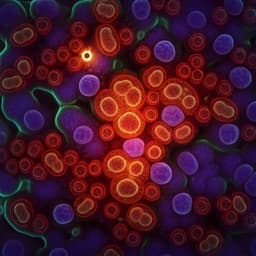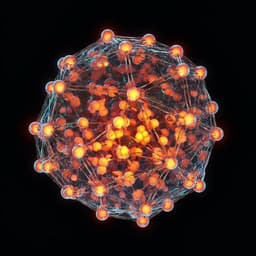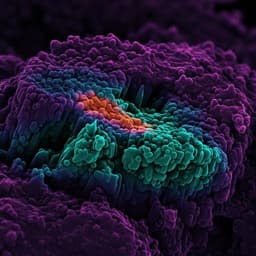
Engineering and Technology
Lead halide perovskite for efficient optoacoustic conversion and application toward high-resolution ultrasound imaging
X. Du, J. Li, et al.
Discover the groundbreaking potential of lead halide perovskites in optoacoustic transducers, as researchers from Huazhong University of Science and Technology achieve record-high performance. Their innovative approach utilizes the unique properties of these materials to create high-resolution ultrasound imaging capabilities in compact devices.
~3 min • Beginner • English
Introduction
The study investigates whether lead halide perovskites, particularly MAPbI3, can serve as superior optical absorbers in optoacoustic (photoacoustic) transducers to simultaneously achieve broad bandwidth and high acoustic pressure for high-resolution ultrasound imaging. The motivation arises from perovskites’ exceptional optoelectronic properties (high absorption coefficient, low defect density, long carrier lifetime, facile processing) and their underexplored thermal characteristics (low thermal conductivity and specific heat capacity). Conventional optoacoustic absorbers (e.g., carbon-based materials) provide good absorption but still lag piezoelectric transducers in bandwidth and pressure. The authors hypothesize that MAPbI3’s low specific heat capacity, low thermal diffusion coefficient, and high absorption will enhance local temperature rise and thermoelastic conversion in PDMS, thereby improving optoacoustic efficiency and bandwidth.
Literature Review
Prior optoacoustic transmitters commonly use composites of carbon materials (candle soot particles, carbon nanotubes, carbon nanofibers) with PDMS due to strong optical absorption and low heat capacity. State-of-the-art CNT/PDMS devices reported −6 dB bandwidths around 39.8 MHz with peak frequency 28.5 MHz and peak-to-peak pressures ~2.72 MPa, but overall performance lags piezoelectric transducers. Thin metal films (e.g., Cr) sandwiched by polymers and CNTs/Au/PDMS structures have also been explored. Separately, perovskites have demonstrated ultra-low thermal conductivity and strong coupling between optical and acoustic phonons, leading to short acoustic phonon lifetimes and limited thermal transport. These insights suggest perovskites could be advantageous absorbers for optoacoustic conversion, though such application had not been reported before this work.
Methodology
- Device concept and modeling: Designed PDMS/MAPbI3/PDMS optoacoustic transducers where MAPbI3 thin films absorb 532 nm nanosecond laser pulses and heat PDMS, which expands to generate ultrasound. COMSOL simulations modeled acoustic fields; analytical models described superposition of forward and backward waves governed by PDMS layer thickness and acoustic impedances.
- Materials and synthesis: Synthesized MAI; prepared MAPbI3 precursor (PbI2 + MAI in DMF/DMSO). PDMS precursor (SYLGARD-184) mixed and degassed.
- Film and device fabrication: PDMS base layer spin-coated and cured (120 °C). Surface activated by ozone plasma. MAPbI3 film deposited by two-step spin coating with diethyl ether antisolvent, then annealed; top PDMS layer spin-coated, forming PDMS/MAPbI3/PDMS. Device variants prepared on flat or concave glass.
- Fiber-based devices: Added 15 wt% PVP to perovskite precursor to suppress coffee-ring effects; dip-coated films on 125 μm fiber ends, annealed; PDMS overcoat applied by dip-coating and cured.
- Characterization: XRD for phase, SEM for morphology, UV–vis with integrating sphere for absorption. Thermal properties measured: thermal diffusion coefficient by laser flash (LFA467), specific heat capacity by PPMS. Device operation: 532 nm pulsed laser (6 ns, 20 Hz, 5 mm spot), acoustic detection using a 125 μm fiber-optic hydrophone (250 kHz–50 MHz, up to 15 MPa), signals recorded by oscilloscope; hydrophone positioned 2 mm from transducer. Stability assessed by water soaking and transmittance at 532 nm.
- Acoustic optimization: Varied PDMS II (back) layer thickness to tune superposition of forward and reflected waves at PDMS–glass interface, analyzing unipolar waveform formation and peak pressure as a function of PDMS thickness.
- Computation: DFT (VASP, PBEsol, PAW, 500 eV cutoff; phonon dispersions via PHONOPY) to compute MAPbI3 phonon spectra and density of states, interpreting optical–acoustic phonon overlap and hybrid modes.
- Imaging setup: Built all-optical ultrasound echo detection and scanning system with co-aligned transmitter (fiber-based transducer) and receiver (fiber-optic hydrophone). FPGA for triggering; DAQ at 250 MS/s. Longitudinal resolution estimated from FWHM of the envelope (~36 μm). Imaging demonstrated on fisheye specimen.
Key Findings
- MAPbI3 optical absorption and thickness: Absorption coefficient at 532 nm α ≈ 6.7 μm−1; 90% absorption achieved with ~340 nm thickness vs ~2.3 μm for candle soot.
- Thermal properties: Specific heat capacity of MAPbI3 ≈ 308 J kg−1 K−1 (280–400 K), significantly lower than carbon materials (e.g., candle soot ~750 J kg−1 K−1; double-walled CNTs ~1600 J kg−1 K−1). Thermal diffusion coefficient of MAPbI3 measured as 0.145 mm2 s−1, much lower than carbon black (0.314), carbon nanofibers (0.342), double-walled CNTs (1.165), multi-walled CNTs (0.678) mm2 s−1.
- Mechanism: DFT phonon calculations show no complete phonon bandgap and overlap between optical and acoustic phonons, with hybrid low-frequency modes from coupling of CH3NH3+ librations/torsions and Pb–I lattice. This facilitates acoustic-to-optical phonon up-conversion (hot phonon bottleneck), reducing thermal diffusion and enhancing local heating.
- Temperature rise estimates (3 mJ pulse−1): ΔT at MAPbI3/PDMS interface ≈ 292 K vs ≈ 38 K for candle soot; ratio consistent with measured conversion efficiencies (MAPbI3 2.97×10−2 vs candle soot 0.441×10−2).
- Acoustic performance (planar device, PDMS/MAPbI3/PDMS): Central frequency 29.2 MHz; −6 dB bandwidth 40.8 MHz (record among optoacoustic transducers). Peak-to-peak pressure 24.89 MPa at 3 mJ pulse−1 (positive ~14.52 MPa). Conversion efficiency η = 2.97 × 10−2 (record). Simulation predicted ~17 MPa peak positive pressure vs experimental ~15 MPa at comparable conditions.
- Effect of PDMS II thickness: Increasing PDMS II to ~5 μm minimized heat loss through glass and optimized forward/backward wave superposition, boosting peak-to-peak pressure from 14.14 MPa (no PDMS II) to 24.89 MPa at 3 mJ; η improved from 0.84×10−2 to 2.97×10−2.
- Stability: Transmittance at 532 nm (~3.14%) unchanged after 5 h water soaking, attributed to encapsulating PDMS layer.
- Fiber-based device and imaging: Miniaturized transmitter on 125 μm fiber produced strong broadband ultrasound; axial (longitudinal) resolution ~36 μm. High-resolution ultrasound imaging of fisheye resolved cornea, iris, and lens; cornea thickness measured ~56 μm, consistent with literature.
- Comparison to literature (Table 1): MAPbI3 device outperforms Cr, candle soot, CNTs, carbon nanofibers, and CNTs+Au composites in bandwidth and conversion efficiency.
Discussion
The findings validate the hypothesis that MAPbI3’s thermal properties (low specific heat capacity and low thermal diffusion) combined with high optical absorption enable superior optoacoustic conversion when interfaced with PDMS. The broadband (40.8 MHz) and high-pressure (24.89 MPa peak-to-peak) outputs surpass prior carbon-based composites, translating into improved axial resolution and strong signal-to-noise ratio in imaging. DFT results corroborate a physical mechanism in hybrid perovskites wherein overlap between optical and acoustic phonons promotes acoustic phonon up-conversion (hot-phonon bottleneck), limiting heat transport away from the interface and enhancing local temperature rise and thermoelastic response. PDMS layer engineering further optimizes waveform superposition and reduces substrate heat loss, maximizing output pressure and efficiency. The successful miniaturization on optical fibers demonstrates practical advantages over piezoelectric probes, including smaller form factors and immunity to electromagnetic interference, making these perovskite-based optoacoustic transducers highly relevant for biomedical imaging and other ultrasound applications.
Conclusion
This work introduces MAPbI3 perovskite as an efficient absorber in PDMS-based optoacoustic transducers, achieving record conversion efficiency (2.97×10−2), broad −6 dB bandwidth (40.8 MHz), and high acoustic pressure (24.89 MPa peak-to-peak). The performance stems from intrinsic thermal properties and phonon dynamics of hybrid perovskites and optimized device architecture. Fiber-integrated implementations further enable high-resolution all-optical ultrasound imaging, exemplified by fisheye structure visualization. Future research could explore: long-term environmental stability and encapsulation strategies; biocompatibility and in vivo safety; optimization across perovskite compositions (e.g., fully inorganic, mixed halides) for robustness and performance; scaling to arrays and beamforming; and integration with multimodal optical probes.
Limitations
- Stability assessments were limited to short-term water immersion (e.g., 5 h with unchanged transmittance); long-term durability under physiological conditions and repeated high-fluence pulsed operation was not reported.
- Performance metrics were primarily demonstrated at 532 nm excitation and specific device geometries; generality across wavelengths and diverse substrates was not extensively characterized.
- The study focuses on MAPbI3; translation to other perovskite chemistries for enhanced stability or reduced toxicity was not evaluated within this work.
Related Publications
Explore these studies to deepen your understanding of the subject.







